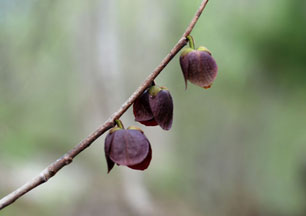PAWPAW
|
 |
| File Size: 27 KB |
|
|
|
Asimina triloba L.
|
| Jefferson County, Kansas |
| Height: 5-30 feet |
| Family: Annonaceae - Custard-apple Family |
| Flowering Period: March, April |
|
| Also Called: | | Indian banana. | | Trunks: | | Erect, 8 to 10 inches in diameter when mature; bark dark brown, often with light blotches, small wart-like protuberances. | | Twigs: | | Branches spreading-ascending, slender; twigs red-brown, hairy when young, later glabrous; buds reddish-brown with golden hairs. | | Leaves: | | Alternate, simple, deciduous; stalk 1/5 to 2/5 inch long, covered with rusty hairs; blade oblong-obovate, 4 to 14 inches long, 3.2 to 6 inches wide, widest near outer end, gradually narrowed to wedge-shaped base, veins conspicuous; margins entire; upper surface green, sparsely hairy on veins, later glabrous; lower surface paler, hairy. | | Flowers: | | 1 to 2 inches across, somewhat foul odor; stalk stout, 2/5 to 1 inch long, brown-hairy; sepals 3, broadly triangular, 1/3 to 1/2 inch long, pale green, dark-hairy on outer surface; petals 6, in 2 overlapping series, egg-shaped, 4/5 to 1 inch long, reddish-purple, leathery; veins prominent; tip pointed; stamens many, in dense globular mass; pistils 3-5. | | Fruit: | | Solitary or 2-4 in drooping cluster; flattened-cylindric, curved, banana-like, 2 to 5 inches long, 1 to 2 inches wide, greenish-yellow, changing to brown or black; flesh thick, yellow, sweet, edible; seeds 2-10, oval, 3/5 to 1 inch long, flattened, wrinkled, dark brown, shiny. | | Habitat: | | Shaded woods, stream banks, and open thickets; prefers being beneath shade of larger trees; rich soils. | | Distribution: | | East 1/3 of Kansas. | | Toxicity: | | The seeds are poisonous. The fruits are edible, but are know to cause allergic reactions in some people. Susceptable people can have digestive disturbances and hives. The fruits can also cause contact dermatitis in some people. | | Uses: | | Native Americans ate the fruit raw or cooked or sun or fire dried them for later use as a hunting food. Cord and cloth were made from the inner bark. | | Comments: | | Pawpaw fruits in September and October. The fruits can be eaten raw or made into pie, jelly, or ice cream. However, some people find the taste nauseating. (See toxicity above.) The flowers have an odor similar to fermented grapes and the crushed leaves are said to smell like motor oil. The common name pawpaw is thought to have come from the South American Indian name for the fruit of Carica papaya. |
|
| Pawpaw petals and sepal |  | | 26 KB | | Jefferson County, Kansas |
| | Pawpaw flower |  | | 25 KB | | Jefferson County, Kansas |
| | Pawpaw flower |  | | 30 KB | | Jefferson County, Kansas |
| | Pawpaw branch |  | | 82 KB | | Jefferson County, Kansas |
| | Pawpaw |  | | 37 KB | | Jefferson County, Kansas |
| | Pawpaw fruit |  | | 53 KB | | Jefferson County, Kansas |
| | Pawpaw leaf |  | | 74 KB | | Jefferson County, Kansas |
| | Pawpaw |  | | 37 KB | | Jefferson County, Kansas |
| | Pawpaw buds |  | | 31 KB | | Wildcat Glades Conservation & Audubon Center, Newton County, Missouri |
| | Pawpaw buds |  | | 27 KB | | Johnson County, Kansas |
| | Pawpaw buds |  | | 29 KB | | Johnson County, Kansas |
| | Pawpaw fruit |  | | 51 KB | | Atchison County, Kansas |
| | Pawpaw leaves |  | | 128 KB | | Atchison County, Kansas |
| | Pawpaw leaves |  | | 130 KB | | Atchison County, Kansas |
| | Pawpaw bark |  | | 145 KB | | Atchison County, Kansas |
| | Pawpaw habit |  | | 243 KB | | Atchison County, Kansas |
| | Pawpaw fruit |  | | 97 KB | | Atchison County, Kansas |
| | | |
|
|
|